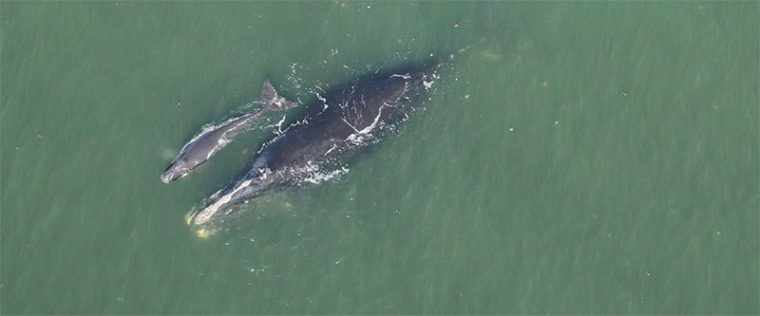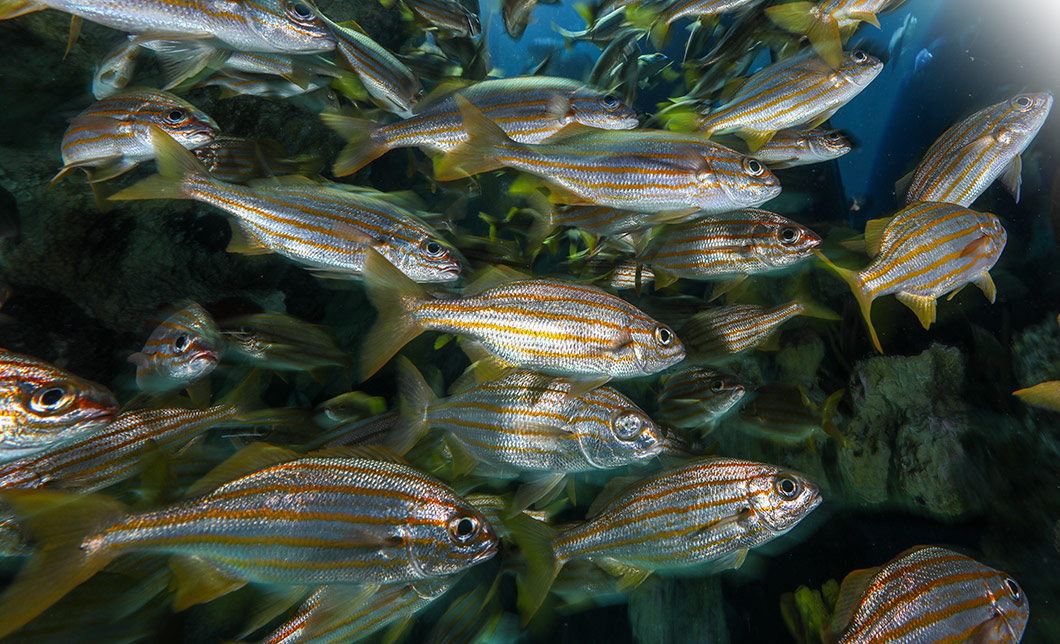We will be closed on Tuesday, April 30, for a day of strategy work and team building.
The New Balance Foundation Marine Mammal Center will be closed for exhibit maintenance on Monday, April 29 and Wednesday, May 1.

BOSTON, MASS. (Jan. 6, 2020) – Amid the growing concern that endangered North Atlantic right whales could be creeping toward extinction due to their declining numbers, every winter calving season offers a chance for hope. On Jan. 2, Harmonia, an 18-year-old right whale who was discovered to be pregnant this summer by the New England Aquarium right whale team, was spotted off Cumberland Island, GA with her newborn calf.
An aerial survey team from the Florida Fish and Wildlife Conservation Commission saw the pair just over seven miles from shore while doing their routine surveys of the right whale calving ground. This is optimistic news for the right whale population, which now stands at around 411, and the third calf spotted in the Southeast this season.
“Every calf gives us hope, and seeing Harmonia, who we’ve watched grow from a calf to a healthy mom, with her third calf is particularly exciting. The future of this species rests on the backs of dependable reproductive females like her,” said Philip Hamilton, a Research Scientist at the Anderson Cabot Center for Ocean Life at the New England Aquarium.
For 40 years, the Aquarium’s right whale team has extensively researched and tracked the endangered North Atlantic right whales with the photo-identification catalog they manage. The scientific team monitors the whales’ arrival at breeding and feeding grounds, registering new calves, death rates, and also measuring changes in stress and reproductive hormones through scat and blow – or whale’s breath – research developed by the team. They collaborate with fishermen on new techniques to reduce deadly entanglements in fishing gear, and they work with lawmakers locally and nationally to lobby for protections for the whales.
On Aug. 7, the team collected a sample of Harmonia’s feces in the Gulf of St. Lawrence, where she was sighted with two other whales. An analysis of her hormones indicated that she was pregnant. By Nov. 23, she was spotted off the coast of Florida, the first right whale spotted in the Southeast this winter, exciting researchers with hopes that she had migrated to warmer waters to give birth. She was seen again on Dec. 10 off the coast of Georgia by the Clearwater Marine Aquarium aerial survey team.
Harmonia is well-known and well-studied by the New England Aquarium team. She was born in 2001 to parents, Aphrodite and Velcro, who are both thought to still be alive. Her name is based on Greek mythology as Harmonia was the daughter of the goddess, Aphrodite. Harmonia has at least six half-brothers and two half-sisters and previously gave birth to two calves – one in 2009 and another in 2016. Her first calf barely made it past its first year before being struck by a vessel and killed during the summer of 2010. Harmonia’s second calf, “Gully,” is still alive but was discovered in 2018 suffering another major threat to right whales – entanglement in fishing gear, leaving severe wounds and a deep gouge in its head.
As the right whale team has developed its health assessment techniques using blow and scat samples from free-swimming right whales, Harmonia has been an invaluable test case. The team was able to gather two blow samples and one fecal sample from Harmonia in 2015. Those samples showed elevated levels of reproductive hormones, characteristic of pregnancy, and she subsequently gave birth to Gully 10 months later. That finding was pivotal because it was the first proof that a sample of exhaled blow could effectively detect pregnancy.
Looking back on Harmonia’s history, she was one of a handful of calves from 2001 who stayed with her mom into her second year – unlike most calves who are weaned by the end of their first year. Harmonia also gave birth to her first calf three years earlier than average and was pregnant by the age of 7. She’s had two suction cup tags attached to her – the first at age two so researchers could understand how she behaved underwater, and the second to assess how she and her calf vocalized. Her blubber thickness has been measured, and she’s been observed by a special aerial camera designed to provide accurate length and width measurement – all in addition to her involvement in the feces and blow hormone studies.
Harmonia has been seen by the Aquarium right whale team in the Bay of Fundy many times and almost every year up until 2011 but has not been seen there since. Due to ocean changes brought on by climate-change, few right whales use the Bay of Fundy now. Harmonia is one of the 130 or so right whales that have adapted and now feed in the Gulf of St. Lawrence where she has been seen every year since 2015.
Here is a sampling of images of Harmonia over the years with specific captions included in the document: https://www.dropbox.com/home/Harmonia%20pregnancy%20blog
For attached photo, here is the proper photo credit:
Florida Fish and Wildlife Conservation Commission, taken under NOAA permit 20556-01
MEDIA CONTACTS:
Pamela Bechtold Snyder, 617-973-5213; psnyder@neaq.org
Diana Brown McCloy, 978-697-9414; Diana@teakmedia.com

